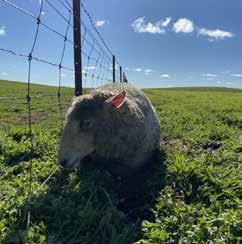Pregnancy toxaemia
Pregnancy toxaemia occurs in sheep, goats, and cattle in response to an insufficient intake of energy to meet the demands of pregnancy.
What is pregnancy toxaemia?
Pregnancy toxaemia in sheep and goats is commonly caused by low levels of glucose in the blood which adversely affects brain and nervous system function. Pregnancy toxaemia is also known as lambing sickness or twin lamb disease, as it occurs in up to 10% of twin-bearing ewes.
Pregnancy toxaemia in cattle is also known as fatty liver syndrome. It is a form of ketosis caused by abnormal metabolism of carbohydrates and fatty acids following a sudden deterioration in feed nutrition during the later stages of pregnancy.
This condition is most commonly seen in the last 6 weeks of pregnancy when the energy demands are not met adequately by the diet.
What causes pregnancy toxaemia?
High demand for glucose from the rapidly developing foetus during the last stages of pregnancy coinciding with a drop in feed quality or bad weather can result in pregnancy toxaemia.
When the animal does not obtain enough glucose from the feed offered, the pregnant ewe or calving heifer will make up for the short-fall in nutrition by mobilising her own stores of body fat. When fat is metabolised for energy it results in the production of ketones as an energy source, which can become toxic over a prolonged period of under-nutrition. If there is a large short-fall, the rapid mobilisation of fat can significantly disrupt the metabolic system resulting in death.
Anything that impacts feed intake in late gestation (for example, a lame ewe in heavy body condition) predisposes the animal to pregnancy toxaemia.
Other common predisposing factors include:
- Multiple foetuses which require an increase in energy (twins also compress the rumen as they develop, consequently decreases voluntary food intake)
- Being overfed leading to increase abdominal fat which reduces rumen capacity (excessive abdominal fat can become deposited in the liver resulting in liver dysfunction).
- Lack of exercise
- Undernutrition
- Stress factors can also play a role in initiating the disease
Clinical signs of pregnancy toxaemia
 In sheep or goats, pregnancy toxaemia is characterised by dullness, inappetence, isolation from the mob with a classic ‘hollowed’ out appearance, progressing to recumbency. Signs can also include apparent blindness and convulsions.
In sheep or goats, pregnancy toxaemia is characterised by dullness, inappetence, isolation from the mob with a classic ‘hollowed’ out appearance, progressing to recumbency. Signs can also include apparent blindness and convulsions.
In cattle, the signs of pregnancy toxaemia include staggering, aggression, and recumbency. When yarded, affected cows may not respond normally to driving, and may appear stubborn or confused
Without early intervention, irreversible metabolic collapse occurs. Unless treated in the early stages, death will occur within a few days of clinical signs first appearing.
How to treat pregnancy toxaemia
The more severe the clinical signs a ewe or heifer is showing, the poorer the prognosis. If treatment is able to be administered to an animal that is still standing, her prospect of recovery is much better compared to a recumbent animal.
Down ewes or ewes standing on their own showing clinical signs should be treated with:
- 4-in-1 Flopack under the skin twice daily.
- Ketol or Vytrate (propylene glycol) orally twice daily.
- Shelter, thick bedding and energy dense feed.
How to prevent pregnancy toxaemia
Prevention is key when talking about pregnancy toxaemia. Best practice is through management of body condition score and provision of high quality, energy dense feed during late gestation and lactation.
- Minimise stress and fasting in the last month of pregnancy.
- Avoid ewes becoming over-fat at joining (they will eat less during pregnancy which places them at risk of pregnancy toxaemia).
- Provide adequate nutrition during pregnancy, with particular attention to the last month of gestation when supplementation is often required.
- Supplement feed with energy dense grains such as lupins and cereal grains.
- Scanning of ewes with separation of twin-bearing ewes to allow provision of a higher plane of nutrition.
Further reading:
Get advice on ewe nutrition.